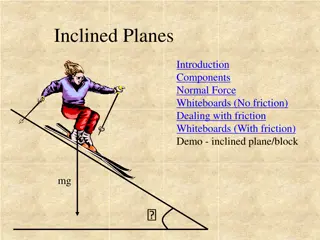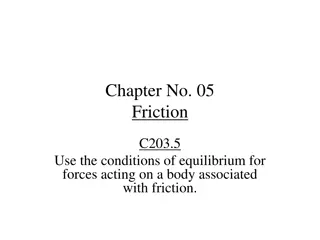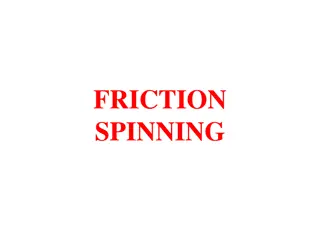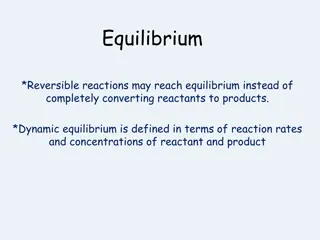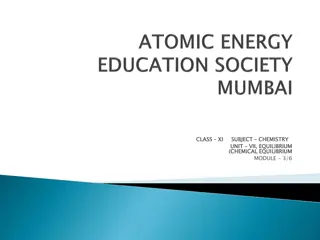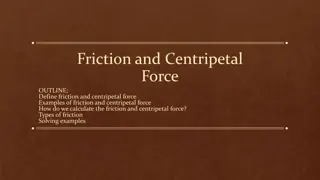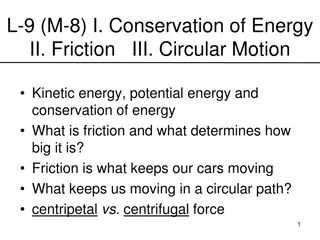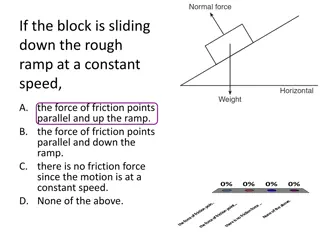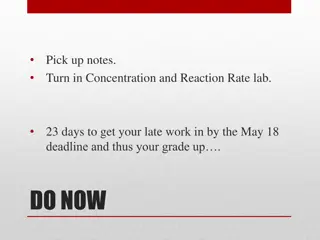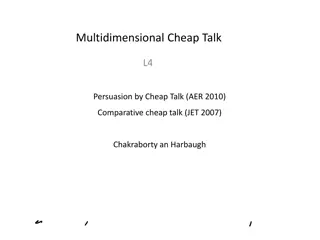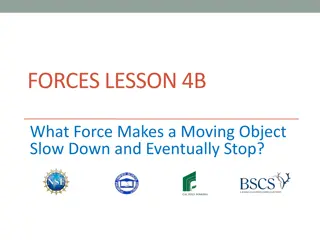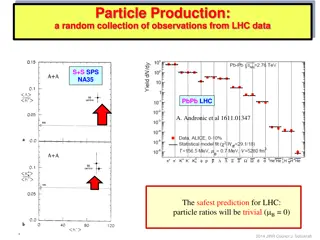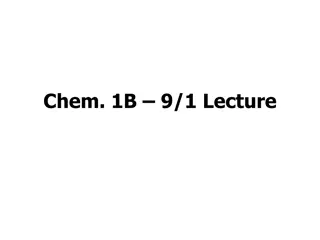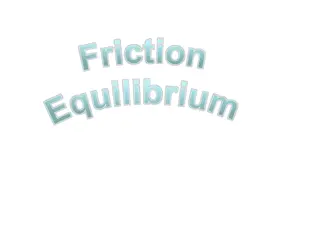
Equilibrium Moments and Coefficient of Friction
Learn how to solve equilibrium problems involving moments and forces at angles, and determine the coefficient of friction in limiting equilibrium scenarios. Explore examples of ladders and rods in different configurations to understand the concepts better.
Download Presentation

Please find below an Image/Link to download the presentation.
The content on the website is provided AS IS for your information and personal use only. It may not be sold, licensed, or shared on other websites without obtaining consent from the author. If you encounter any issues during the download, it is possible that the publisher has removed the file from their server.
You are allowed to download the files provided on this website for personal or commercial use, subject to the condition that they are used lawfully. All files are the property of their respective owners.
The content on the website is provided AS IS for your information and personal use only. It may not be sold, licensed, or shared on other websites without obtaining consent from the author.
E N D
Presentation Transcript
Equilibrium Moment at angles and coefficient friction
Moments: At an angle KUS objectives BAT solve EQUILIBRIUM problems using moments and forces at angles to a rod/ object using sohCahToa Starter:
Limiting Equilibrium: This is when the magnitude of the frictional force is just sufficient to prevent relative motion Friction is a Force on objects caused by a touching surfaces resistance to a direction . Rougher surfaces cause greater friction The coefficient of friction is a measure of this roughness of different surfaces. There is a direct relationship between friction and the reaction force when an object is touching a surface when a particle is in equilibrium and static ???????? ?? ???????? = ?? when a particle is moving Remember: An object moving at a constant velocity will still be in equilibrium An accelerating object is subject to F=ma
WB40a A ladder PQ of mass 10 kg and length 6 m rests with the end P on rough horizontal ground. The other end Q rests against a smooth vertical wall. A child with mass 20 kg stands at the top of the ladder at Q. The ladder is modelled as a uniform rod in a vertical plane perpendicular to the wall and the load as a particle. The ladder rests in limiting equilibrium at an angle of 65 with the ground. Find the coefficient of friction between the rod and the ground N ? Use R with the rough surface 3 20g Remember ?? = ? R R Friction is NOT related to N 65 R 3 10g Careful with cos and sin ! 65 65 65 ?? ?
WB40b N ? R( ) R = ??? + ?? ? = ??? 3 20g At equilibrium ?? = ? R R = ???? 65 R 3 10g 65 M(Q) ???????? ? + ?? ??? ?? ? = ???? ?? ? 65 65 ?? ? ???????? + ????? ??? ?? = ???? ??? ?? ? =180 ??? 65 30???65 180 ??? 65 = ?.???
WB41 A uniform rod PQ of mass 40 kg and length 10 m rests with the end P on rough horizontal ground. The rod rests against a smooth peg C where PC = 8 m The rod is in limiting equilibrium at an angle of 15 to the horizontal. Find a) The magnitude of the reaction at C b) The coefficient of friction between the rod and the ground ? 75 a) M(P) ? ? 40? ? 8 = 40? 5cos15 15 40? 5 cos 15 8 ? at C ? = = 236.7 ? ???????? b) Equilibrium in horizontal direction ???????? = ?cos75 = 236.7cos75 = 61.25 Equilibrium in vertical direction ? + ???? 75 = 40? ? = 40? 236.7cos75 = 163.4 ? ? =?? ?=61.25 Coefficient friction 163.4= 0.375
WB42a A ladder PQ of mass m kg and length 3a m rests with the end P on rough horizontal ground. The other end Q rests against a smooth vertical wall. A load of mass 2m is fixed on the ladder at point C, where AC = a. The ladder is modelled as a uniform rod in a vertical plane perpendicular to the wall and the load as a particle. The ladder rests in limiting equilibrium at an angle of 60 with the ground. Find the coefficient of friction between the rod and the ground N Add all the forces to the diagram ? Wall smooth No friction Equilibrium in horizontal direction 2? ???????? = ? ? R Equilibrium in vertical direction ? ? = 2?? + ?? = 3?? 60 ? ????????
WB42b (cont)A ladder PQ of mass m kg and length 3a m rests with the end P on rough horizontal ground. The other end Q rests against a smooth vertical wall. A load of mass 2m is fixed on the ladder at point C, where AC = a. The ladder is modelled as a uniform rod in a vertical plane perpendicular to the wall and the load as a particle. The ladder rests in limiting equilibrium at an angle of 60 with the ground. Find the coefficient of friction between the rod and the ground N M(Q) to get an equation with Friction and R ? ? 3?cos60 = ?? 3?sin60+?? 3 2? 2?cos60 + 2?? 2?cos60 ? R Substituting ?? = ?? and R = 3?? 3?? 3?cos60 = ?3?? 3?sin60+?? 3 ? 2?cos60 + 2?? 2?cos60 60 ? Friction Cancel by mga and rearrange to 7 2cos60 9sin60=7 3 3 3cos60 +3 2cos60 2 2cos60 3 3sin60 = = 0.225 ? = 54
WB44 Exam Q A uniform ladder AB, of length 2d and weight W, has its end A on rough horizontal ground. The coefficient of friction between the ladder and the ground is 1 4 . The end B of the ladder is resting against a smooth vertical wall, as show. A builder of weight 7W stands at the top of the ladder. To stop the ladder from slipping, the builder s assistant applies a horizontal force of magnitude P to the ladder at A, towards the wall as shown. The ladder rests in equilibrium in a vertical plane perpendicular to the wall and makes an angle with the horizontal ground, where tan? =5 as a uniform rod. (a) Show that the reaction of the wall on the ladder at B has magnitude 3W. (5) (b) Find, in terms of W, the range of possible values of P for which the ladder remains in equilibrium. (5) Often in practice, the builder s assistant will simply stand on the bottom of the ladder. (c) Explain briefly how this helps to stop the ladder from slipping. (3) 2. The builder is modelled as a particle and the ladder is modelled a) M(A) ? ??? ? ? + ????? ? ?? = ? ??? ? ?? ? ? ? + ??? = ?? ??? ? ?? ? ??? ???? ? = ?? ? = ?? ? ? Fr 75 ? ?
WB44b Exam Q a) Show that the reaction of the wall on the ladder at B has magnitude 3W. (5) (b) Find, in terms of W, the range of possible values of P for which the ladder remains in equilibrium. (5) ? b) R( ) ? = 8? ? = ?? ?? ? ?? = ? R R =1 4 8? = 2 ? ?? ? ? If the ladder is about to move right due to P then Friction is at its maximum R( ) ????= ? + ?? = 3? + 2? = 5? Fr 75 ? ? If the ladder is about to move left then friction acts in the opposite direction R( ) ????= ? ?? = 3? 2? = ? So W ? 5?
WB44c Exam Q Often in practice, the builder s assistant will simply stand on the bottom of the ladder. (c) Explain briefly how this helps to stop the ladder from slipping. (3) c) Three marks ! ? ? = ?? ?? First, N is unaffected by the assistant standing on the ladder, same moments equation, same value N M(A) ? ?? ? ? ? ??? ? ? + ????? ? ?? = ? ??? ? ?? Fr 75 Second, R increases when the assistant stands on ladder R( ) ? = 8? + ? ? ? Third, R increases so the value of limiting friction (max Friction) increases which helps stop the ladder from slipping
WB44 Two interlocking gears are in equilibrium. The gear on the right has a radius of 10 cm and has a loop 8 cm from the centre. The loop is to the right of, and level with the centre of the gear. A 10 kg mass hangs from the loop. The other gear has a radius of 5 cm and a loop 2 cm from the centre. The loop is to the left of, and level with the centre of the gear. A mass M kg hangs from the left loop. Find the value of M. Q from exemplar materials 2017 (no friction)
WB10Two interlocking gears are in equilibrium. The gear on the right has a radius of 10 cm and has a loop 8 cm from the centre. The loop is to the right of, and level with the centre of the gear. A 10 kg mass hangs from the loop. The other gear has a radius of 5 cm and a loop 2 cm from the centre. The loop is to the left of, and level with the centre of the gear. A mass M kg hangs from the left loop. Find the value of M. Weight of right mass is 10g (N) Moment on right gear is force distance from centre of right gear Moment = 10g 0.08 = 0.8g (N m) =0.8? 0.1= 8? ?????? ???????? Force on left gear by right gear is Moment on left gear is force distance from centre = 8g 0.05 = 0.4g (N m) ?????? ???????? =0.4? 0.02= 20? ???? ? = M = 20g g= 20 (kg)
KUS objectives BAT solve problems using moments and friction at angles to a rod/ object using sohCahToa self-assess One thing learned is One thing to improve is

